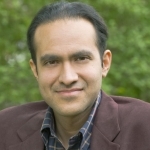 (Host)
(Host)
This week, as we observe the legacy of Dr. Martin Luther King,
commentator and UVM Professor Saleem Ali has been thinking about how
nonviolent protest in the twentieth century was learned – across
cultures.
(Ali) I recently had an opportunity to visit the
neighborhood where Dr. Martin Luther King grew up in Atlanta , Georgia .
A tranquil pool greets visitors to the King C enter which is crowned
with the sarcophagus containing the remains of Dr King and his beloved
wife Coretta Scott King. Along one side of the complex is a pavement
full of memorial plaques, with footprints of some of the great civil
rights activists who assisted Dr King.
Near the entrance , there
is a bronze statue of a foreigner – Mohandas Kamarchand Gandhi – a man
whom Dr King credited as an inspiration for his practice of nonviolent
activism. The statue was donated by the Indian embassy but it is clearly
well-placed in this memorial.
Beside Gandhi’s statue is a
quotation by Albert Einstein in memory of Gandhi, which still rings
true: "generations to come will scarce believe that such a one as ever
in flesh and blood walked upon this earth." And even though the two
icons of nonviolence never met each other, Dr King made a special visit
to India in 1959 to learn about Gandhi ‘s nonviolent techniques of civil
disobedience.
Some revisionist historians claim that the fall
of the British Empire was more likely caused by the crumbling of
resources following World War II than by Gandhi’s struggle, but its
impact on Dr King and the American Civil Rights Movement can never be
underplayed. It was because of his strategy of nonviolence that Dr. King
was able to garner so much support and ultimately prevail. Resorting to
other violent means would have perpetuated the struggle by
marginalizing activists as "terrorists".
This struggle between
strategies was clearly evident in other aspects of the American Civil
Rights movement as well. In contrast to Dr King, leaders such as Malcolm
X initially advocated more violent means to reach their goals. Malcolm X
started out as a member of the misnomered Nation of Islam, but
subsequently converted to mainstream Islam. It’s interesting to note
that his pilgrimage to Mecca was a transformational experience as it
moderated his views from violence to nonviolence and from prejudice to
egalitarianism. The same faith that is so often stereotyped today as the
source of violence was in fact what catalyzed peace in Malcom X.
The
story of the Civil Rights movement is thus one of cross-cultural
learning and a quest for equality and rights that can be derived from
East and West alike. It is a story that continued a few decades later
back at the mother continent of Africa where Nelson Mandela languished
in prison for 18 years. When asked about how he survived Mandela said
simply – "I always remembered that my captors were also human."